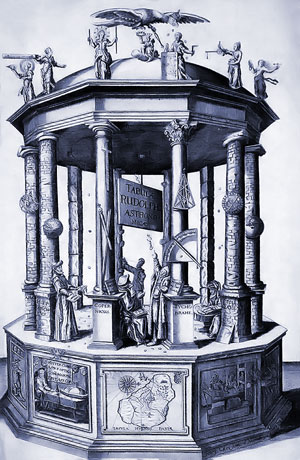
Cover of Johannes Kepler’s Rudolphine Tables
What is Mathematics
Even though everyone learns mathematics at school, it is difficult to define exactly what mathematics is. Clearly numbers, shapes and equations form part of it, but only a small part compared to the vast space of mathematical concepts and ideas. The best way to understand what mathematics is and what mathematicians work on – is to do mathematics.
One idea that appears everywhere in mathematics is abstraction. Instead of thinking about particular numbers, shapes, equations or any other objects, mathematicians tend to think about their underlying structures and patterns. This means that the results, called Theorems, are more general and provide deeper insight.
Another fundamental idea in mathematics is Proof. Mathematicians can’t just say that an idea is true, or test it in a few cases. They need a rigorous and watertight argument to deduce that it is always true. Maybe this makes mathematics more difficult than other sciences, but it also means that mathematicians can obtain absolute and definitive knowledge – which is impossible in any other discipline.
Despite being so abstract and theoretical, mathematics has countless applications in every possible aspect of life. Without mathematics our civilisation would be little more advanced than the ancient Egyptians: we wouldn’t have governments funded by a tax system, no phones, no television, no computers, no internet and no satellite navigation. The cultural value and the monetary economic value of mathematics are too large to measure.
Mathematics is also the language of the universe, from the electrochemical signals in our brain to the equations of General Relativity which govern the motion of stars and galaxies everywhere in the universe. It is one of humanity’s most noble endeavours to understand the universe we live in, and that would not be possible without mathematics.
 Teaching Mathematics
Teaching Mathematics

Government and industry often advertise mathematics with its importance and usefulness. And rightly so – many of the most innovative job areas require a significant amount of mathematics: from engineering to software development, science and finance. But in addition to its practical applications, studying mathematics teaches many important skills: from reasoning and logical thinking to writing precise and clear arguments.
Unfortunately mathematics is one of the most unpopular subjects at school. Maybe this is because mathematics is very difficult. Maybe because it can be dry and abstract, and because much of the content does not seem particularly useful – especially if we have computers and calculators. There have been countless debates regarding what mathematics teaching should look like. Should children have to learn long division? Trigonometry? Fractions?
It is important to remember that, in mathematics, the process of learning something is usually just as important as the result. Even if, because of calculators, you never actually have to use long division, the process of understanding how it works teaches abstract thinking and gives important insights into what decimal numbers are. Maybe schools should focus more on helping students discover particular results on their own, rather than just tell them a procedure to memorise.
What is the World of Mathematics
The World of Mathematics is an interactive eBook available online and on mobile devices. Using some of the most advanced web technologies and educational principles, we want to make advanced mathematical ideas as accessible and exciting as possible. The articles don’t usually require any prerequisite knowledge, especially since the topics are usually unrelated to the school mathematics curriculum. We have chosen 30 of the most exciting, interesting or useful areas of mathematics and ordered them in five chapters. However it is possible to read each of the articles on their own.
In this eBook, mathematical ideas come to life using animations, slideshows, games or computations. Many of the numbers in the text are actually variables – users can change them and the remaining text updates accordingly. Countless images and videos make mathematics more colourful than ever before.